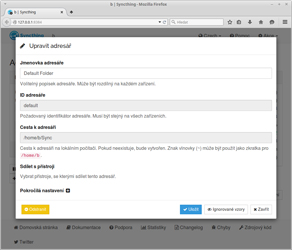

In settings, the authorization data is set in the GUI tab. The next thing you should do is go to settings and create a username and password. You can ackknowlege the usage statistics or not. Once it has started, your web browser will pop up just like in a wifi hotspot. Once, you launch the application, it takes about three minutes to start up. This is how it looks added to the startup applications. Here is adding it to the startup applications. In linux, I just double click the Syncthings startup and then add it to the startup application folder. In the case of Windows, you just run the installation package.
#Syncthing introducer archive
I extract the folder strructure from the archive and I place it in my home folder. Below I am downloading the Linux version of Syncthings. Installing Syncthing involves a couple steps.

The sharing tab indicates which clients that a given folder are sharing to. Syncthings usually makes this a random string of characters. The folder label is just a name, but the Folder ID needs to be the same is on the system sending the data, because that is a way to identify that it is the same folder. I have chosen to only replicate to the NAS rather than bidirectionally.įolder definition on the NAS provides the path to replicate the incoming data into. My phone replicates its DCIM Camera folder to the QNAP NAS. The screenshot below shows three computers that I am replicating and my phone. The difference is that I access the interface from my NAS address rather than the lapback address on the device locally. My Syncthings configuration on my QNAP NAS is a Syncthings client like all other installations of the product. SyncThings also has the concept of “versioning” where it can keep track of multiple versions of a file according to rules that you establish.Įach Syncthings client can replicate one or more folders with one or more client devices. Communication is bidirectional and it is possible to replicate in either one or both directions. The actual replication take place via TLS on TCP/UDP port 22,000. A client computer has the Syncthing web interface offered on. I installed Syncthings on QNAP QTS as a QPKG through the QNAP Club store. Syncthing is available for a broad set of devices including Windows, macOS, Linux and Android. In order to lower your threat surface, I would be inclined to configure Syncthings for the LAN and handle replication only when you are on your home network or when you have a VPN connection to your home network. Syncthings can work over the LAN or over the Internet. It’s possible to replicate a folder structure across many clients as well. This tool is essentially server-less since it consists of clients which all have peer relationships. Syncthing is a file/folder replication tool which consists of a Web client.


 0 kommentar(er)
0 kommentar(er)
